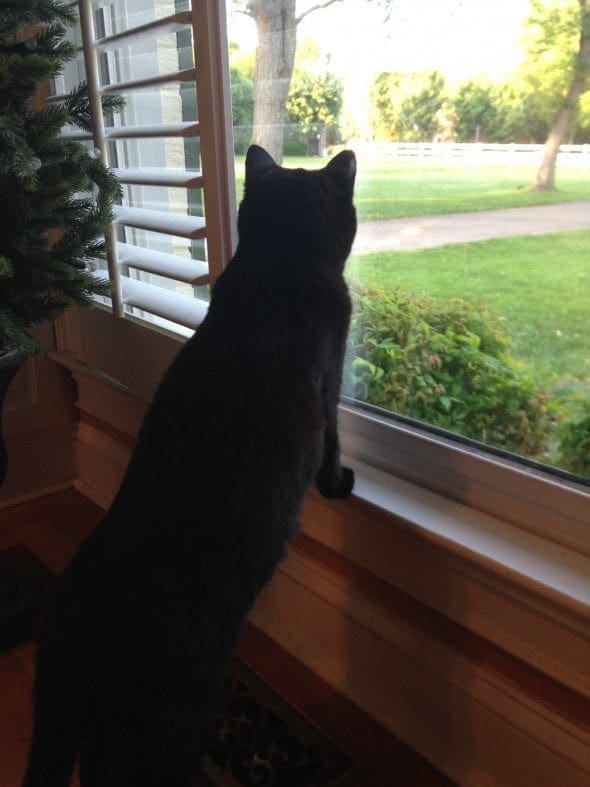First, let me start by saying not every cat is a candidate for leash training. As with any type of training, there’s a learning curve but if your cat is easily stressed or you think she’ll never be comfortable, then don’t do it. You know your cat. Use that knowledge to make a sound decision that will benefit her and not stress or endanger her. Age is also a factor here. It’s much easier to train a kitten to accept leash-walking.
Leash Walking Your Cat Indoors is Vastly Different from the Outdoors
I’m a big proponent of leash training indoor cats but that doesn’t mean every cat should be walked outdoors. Cats are territorial and scent plays a huge role in their lives. When you take a cat outdoors she’ll be bombarded with endless unfamiliar scents. Some of those scents may be threatening. Additionally, cats can easily be startled by dogs outdoors, loud noises, cars, and even people walking by. If you think trying to hold a terrified and defensive cat in your arms as you head back to the safety of the indoors is easy, let me tell you it isn’t! This is how people and cats get injured and this is how cats escape from your control and get lost. So think carefully before you decide that walking outdoors is a good option. Know your cat, plan to only walk within your yard, and take precautions. Place a heavy towel over your shoulder before you head out for the walk so at the very least, you can wrap the cat in it should she panic. Another thing to consider is that your indoor cat, once she’s exposed to the outdoors, will be susceptible to parasites such as fleas and ticks. Make sure you plan in advance and begin flea/tick (and even heartworm) preventatives well in-advance of going outside. Finally, since the unthinkable can happen where your cat escapes, make sure she’s microchipped. As an extra precaution, have visible ID on her as well. The ID should say “indoor cat” so anyone coming across your cat will know she isn’t street savvy.

Photo: Pam Johnson-Bennett
Unwanted Behaviors
Walking your cat outside on a leash may seem like the best of both worlds but keep in mind your cat may decide she should be in charge of the walking schedule. This means she could begin a behavior of meowing at the door. She could also become a door darter when the door is opened if she feels you aren’t taking her outside often enough. So think carefully before rushing into this new adventure.
Have the Right Equipment for Leash-Walking Your Cat
You’ll need a harness made especially for cats or a walking jacket for cats. Don’t use a collar because your cat will easily slip out of it. The other danger with a collar is that your cat could get strangled on a tree branch if she escapes from you. Your best bet is a cat harness or a walking jacket. I recommend the walking jacket because it provides more comfort, is more secure and cradles the cat with even an even amount of pressure. On a cat harness or the walking jacket, the leash attachment is more toward the middle of the cat’s body as opposed to right at the neck the way it is with a collar. This is more comfortable for the cat and much safer.
You’ll have to get the right size harness or jacket for your cat. Measure your cat’s girth, just behind her front legs. Different manufacturers of jackets and harnesses will have more specific instructions on exactly where and how to measure so follow those specific directions.
Start Slow With Your Cat
You can’t just slap a harness or jacket and leash on a cat and expect her to be comfortable and know what to do. The training process involves gradual desensitization.
Initially, just leave the harness or walking jacket on the floor for your cat to sniff and investigate. When she’s comfortable with that you can put the harness or jacket on (but not too snug) while kitty eats dinner or gets super yummy treats. Gradually increase the time she wears it. Work up to being able to adjust the harness or jacket so it fits appropriately. The next step is to attach the leash and hold it loosely while she walks around. In some cases, it may be easier to let her drag the leash but just be careful she doesn’t get caught on anything or else you’ll have a panicky cat on your hands who will never want anything to do with a leash again. Have treats with you so you can distract her and also reward her when she shows any sign of being calm. Remember this process is all to be done strictly indoors.
One way to entice your cat to walk alongside you is to hold the treat at her level just a few inches in front of her. Hopefully, she’ll walk toward it. After she eats that treat, hold another a few inches away again. Keep in mind that as her hunger decreases, so will her level of compliance. You also don’t want to fill her up with treats so break them into small pieces and keep your training sessions short.
Credits: Pam Johnson-Bennett and catbehaviorassociates.com

